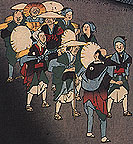| The
Tokugawa, or Edo, period (1603-1868) witnessed the emergence of a
lively urban culture fueled by the wealth of merchants, the work of
artisans, and the spirit of play among chônin
(townspeople). As the seat of the Tokugawa bakufu and the focus of
the sankin-kôtai
system for regional lords (daimyô),
the city of Edo
would attract not only urbanized samurai, but also the providers of
the goods and services that they would require. While the elite samurai
class may have ruled politically, the cultural trendsetters of Edo
Japan were merchants, artisans, courtesans, actors, and those who
wrote about them. |
|
In a
sense, all roads led to Edo, and the most important one was the Tôkaidô.
It connected Kyoto
and the bustling wholesale merchant center of Osaka to
the rapidly growing shôgunal capital of Edo. Dotted with
inns, teahouses, brothels, and relay stations, the Tôkaidô was
as celebrated in word and image as Edo itself. There was an array
of popular literature, picture-books, and woodblock prints (ukiyo-e,
nishiki-e)
that depicted the famous sights and variety of life along the Tôkaidô and
in Edo. In fact, urban fiction and the mass medium of woodblock prints
are perhaps the most insightful forms of historical documentation
of the social and cultural life of Edo Japan.
|
This
Engaging Vision provides, via ukiyo-e, a sense of what you might have
encountered on a trip to Edo. To begin, join these rural visitors to
Edo by tapping them with your finger:

|